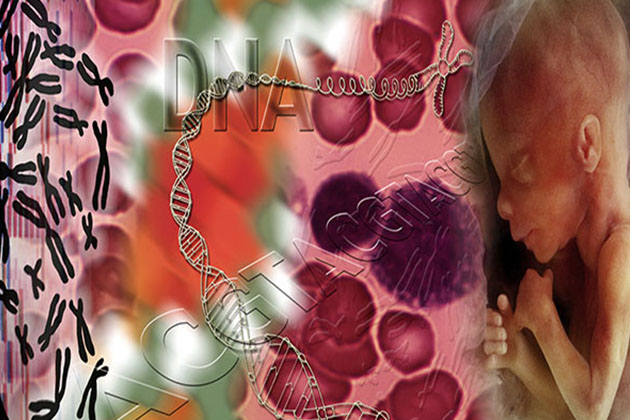Study shows promise for treating genetic disease in a mammal during foetal development in the first three months of a pregnancy
A genetic disorder is a condition or a disease which is caused by abnormal changes or mutations in a person’s DNA in the gene. Our DNA provides the required code for making proteins which then perform most of the functions in our body. Even if one section of our DNA gets altered in some way, the protein associated with it can no longer carry out its normal function. Depending upon where this change happens either it can have a little or no effect or it might alter the cells so much that it could then lead to a genetic disorder or illness. Such changes are caused by errors in DNA replication (duplication) during growth, or environmental factors, lifestyle, smoking and exposure to radiation. Such disorders are passed on to the offspring and start to occur when the baby is developing in mother’s uterus and are therefore referred to as ‘birth defects’.
Birth defects can be minor or extremely severe and may affect appearance, function of an organ and some aspect of physical or mental development. Millions of children are born annually with serious genetic conditions. These defects can be detected during pregnancy as they are evident within the first three months of pregnancy when the organs are still forming. A technique called amniocentesis is available for detecting genetic abnormalities in the foetus by testing amniotic fluid extracted from the uterus. However, even with amniocentesis, treating them is not possible as no options are available to make any corrections before birth of the baby. Some of the defects are harmless and require no intervention but some others can be of serious nature and may require long-term treatment or even be fatal for the infant. Some defects can be corrected shortly after birth of the baby – example within a week’s time – but mostly it is too late for treatment.
Curing genetic condition in an unborn baby
For the first time the revolutionary gene editing technique has been used to cure a ‘genetic disorder’ in mice during foetal development in the uterus in a study by researchers at Carnegie Mellon University and Yale University. It is well established that during early development in the embryo (during first three months of a pregnancy) there are many stem cells (an undifferentiated cell type which can become any type of cell upon maturation) that are dividing at a fast rate. This is the pertinent time point where a genetic mutation if corrected would reduce the impact of the mutation on embryo-to-foetal development. There are chances that a severe genetic condition could even be cured and the baby is born without the unintended birth defects.
In this study published in Nature Communications researchers have used a peptide nucleic acid-based gene editing technique. This technique has been used before to treat beta thalassemia – a genetic blood disorder in which haemoglobin (HB) produced in the blood is reduced considerably which then affects normal oxygen supply to various parts of the body leading to severe abnormal consequences. In this technique, unique synthetic molecules called peptide nucleic acids (PNAs) (made of a combination of synthetic protein backbone with DNA and RNA) were created. A nanoparticle was then used to transport these PNA molecules along with “healthy and normal” donor DNA to the location of a genetic mutation. The complex of PNA and DNA identifies the designated mutation at a site, PNA molecule then binds and unzips the double helix of mutated or faulty DNA. Lastly, donor DNA binds with the mutated DNA and automates a mechanism to correct the DNA error. The main significance of this study is that it was done in a foetus, thus researchers had to use a method analogous to amniocentesis wherein they inserted the PNA complex into the amniotic sac (amniotic fluid) of pregnant mice whose foetuses were carrying the gene mutation which causes beta thalassemia. After one injection of PNA, 6 percent of mutations got corrected. These mice showed improvement in symptoms for the disease i.e. levels of haemoglobin were in normal range which could be interpreted as the mice being ‘cured’ of the condition. They also showed increased survival rate. This injection was in a very limited range but researchers are hopeful that even higher success rates can be achieved if injections were done multiple times.
The study is relevant because no off-targets were noted and only the desired DNA was corrected. Gene editing techniques like CRISPR/Cas9 though are easier to use for research purposes, it is still controversial because it cuts the DNA and carry out off-site errors as they damage an off-target normal DNA as well. Because of this limitation they are not ideally suited for designing therapies. Considering this factor, the method shown in the current study only binds to the target DNA and repairs it and shows nil offsite errors. This targeted quality makes it ideal for therapeutics. Such a method in its current design could also be potentially used to ‘cure’ other conditions in the future.
***
{You may read the original research paper by clicking the DOI link given below in the list of cited source(s)}
Source(s)
Ricciardi AS et al. 2018. In utero nanoparticle delivery for site-specific genome editing. Nature Communications. https://doi.org/10.1038/s41467-018-04894-2
***






































